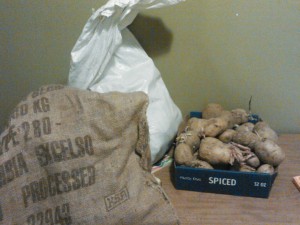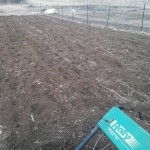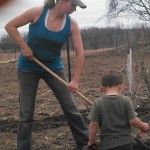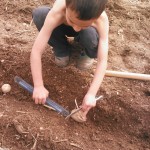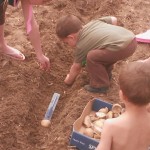When my potatoes begin sprouting in storage during the spring, I get excited. That means I can plant more potatoes and not have to worry about buying seed potatoes. This method goes for white potatoes – sweet potatoes are a whole other ball of wax – which I will write a tutorial on soon, too. If you find yourself with sprouted potatoes and don’t plan to use them, seek out a gardening friend to give them to – you just might make his or her day!
I think around here a little bag of seed potatoes are about $3-4 each (and they are really little). You get a little bag full of small, sprouted potatoes and you can usually cut them in half if they have 2 or more sprouts – maybe into thirds if you are lucky. If you aren’t trying to grow a couple hundred pounds of potatoes or more, they can be a great deal. But if you are trying to grow a large quantity, those bags of seed potatoes will get mighty expensive when you consider the rest of your expenses with seeds, etc.
Or, you can use your sprouted potatoes as seed potatoes and save some money. I’m all for seed saving and reducing costs in the garden because in turn that saves us money and makes the food we eat cost our large family even less, so using sprouted potato as ‘seed’ is right up my alley.
If you notice your potatoes are starting to sprout late winter/early spring, set them aside in a cool, dark area if you have one. This will prevent the sprouts from growing several feet long by the time you plant them (although, I HAVE planted them when they have grown that long and they will produce just fine… just a pain). If you are trying to encourage sprouting, keep the potatoes in a warmer area exposed to light. I currently have a feed bag about half full with the remaining potatoes that had not sprouted or were just beginning to sprout, when I put potatoes in a few days ago. Many of them are growing nice sprouts now.
When it comes time to plant, you will want to begin the cutting process a day or few in advance to allow your cut edges to scab over – this prevents the potato from rotting as soon as its put in dirt. If you have a sunny, windy location your potatoes may scab over in about half day or maybe even less. Otherwise you might want to cut and let the exposed sides face up for a few days indoors, or set them under a fan (which is what I’m doing tonight, so they can be planted tomorrow).
To cut, count how many eyes/sprouts are growing. You want to cut your potato into blocks, with at least one sprout on each block. They may not all look like a block depending on where you have to cut the potato, but the more sprouts you have, the more plants you can grow. You want to keep your blocks at least the size of a large ice cube – the potato that remains with the sprout will feed the potato and give it the nutrients it needs to continue growing and push through the dirt that will be on top of it, so its important not to cut the pieces too small.
It’s not rocket science. Look, cut, dry, then plant.
- The potato patch (1 of 3)
- Making the trenches
- My potato planting helper
- Popcorn, one of our barn cats
- Planting potatoes is serious business!
- Even the 2 year old helps with potato day
Planting is great fun, especially for kids. Potatoes are not like delicate seedlings that can easily become squished or have the roots pulled off, so kids can help without too much damage. Even my two year old got to help. First we rototilled a potato patch, then made trenches to set the potato pieces in. My first patch is 15×50. I allowed about 3ft. of space between each row to allow plenty of room for potatoes to grow (they grow from the side of your seed potato, so you want to make sure your soil is very loose, drains well, and make sure there is enough room between rows for growth). We spaced potatoes about every 12-18 inches, then covered them with a few inches of dirt. As your potatoes grow, you will want to continue ‘hilling’ your plants – mounding dirt up around the plant as it grows to keep the developing potatoes covered and allow growth. You can mulch with straw to keep weeds at bay
I have successfully grown potatoes in 5 gallon buckets, as well. I drilled a bunch of holes in 5 gallon buckets, threw in some rocks for drainage, a layer of straw, dirt, potato, and covered with a light layer of dirt and additional straw. As the plant grew taller I kept making sure there was plenty of straw in the bucket and potatoes along the stem as it grew.
I will follow up with harvesting later this season but you basically want to harvest once the plants have died back in the fall. Give the potatoes about a week after the stems die, then gently dig them up. You will want to allow time for the potatoes to dry which will also toughen them up for storage. Avoid washing with soap and water until you are ready to use them.
